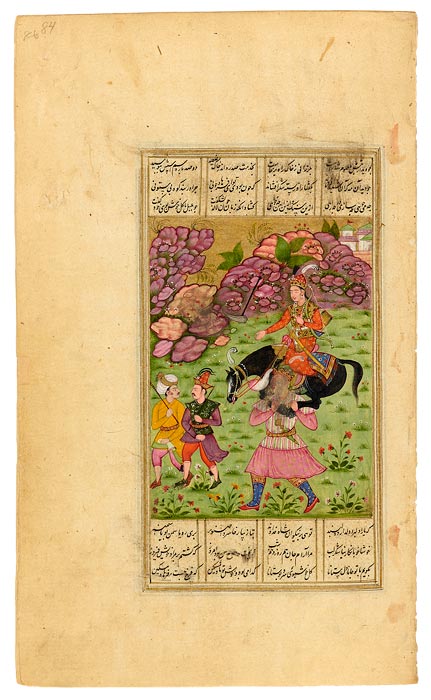
Khusrau, in order to seek peace between Persia and Byzantium, had to marry the king's daughter, Maryam, promising to take no other wife. Meanwhile, Shīrīn's aunt died, became the ruler of Armenia, and eventually heard of Khusrau's marriage. But they were still loyal to each other and wanted to meet. Shīrīn, who did not have access to milk, commissioned Farhād (a friend recommended by Shāpūr) to build a channel connecting her pasture to the palace. Farhād fell madly in love with Shīrīn. When Khusrau learned of his devotion, Khusrau asked him to cut a road through Mount Bisutum. After he arrived there he sculpted images of Shīrīn and Khusau Riding Shabdīz. When Shīrīn learned of Farhād's sculptures she went to visit him on Mount Bisutum, stirring his passions all the more. When she left, her horse stumbled, doubtless tired from the ascent up the mountain. Farhād, who was exceedingly strong, then picked up both Shīrīn and her horse, carried them down the mountain, and to the gate of her palace.
This episode appears in Khusrau va Shīrīn (1180), the second story in Niẓāmī's Khamsa (Quintet).
Persian poetry
The Persians loved their poetry and their poets, though the Qur˒an warned against believing their words (sura 69.41) and "those straying in evil who follow them" (sura 26.224). While Arabic was the first language of Islam and the language of the Qur˒an, Persian was favored by poets. Even Firdausī's (940–1020) celebrated Shāhnāma (Book of Kings), the national epic of Persian, was written in verse—some 50,000 couplets! Rūmī (1207–1273), the best known of the Sufi poets, put poetry in perspective when he wrote, "A hundred thousand books of poetry existed / Before the word of the illiterate [Prophet] they were put to shame!" (Masnavī I, 529). Presented here are illustrations of Firdausī's Shāhnāma as well as works by Sa˓ dī (ca.1184–1292), Hāfiz (ca. 1320–1389), and Jāmī (1414–1492), regarded as the last of the great Sufi poets. Also featured are illustrations from each of the five poems of the Khamsa (Quintet), by Niẓāmī (ca. 1141–1209), especially Lailā and Majnūn (The Persian Romeo and Juliet) and Bahrām Gūr's Seven Princesses.
